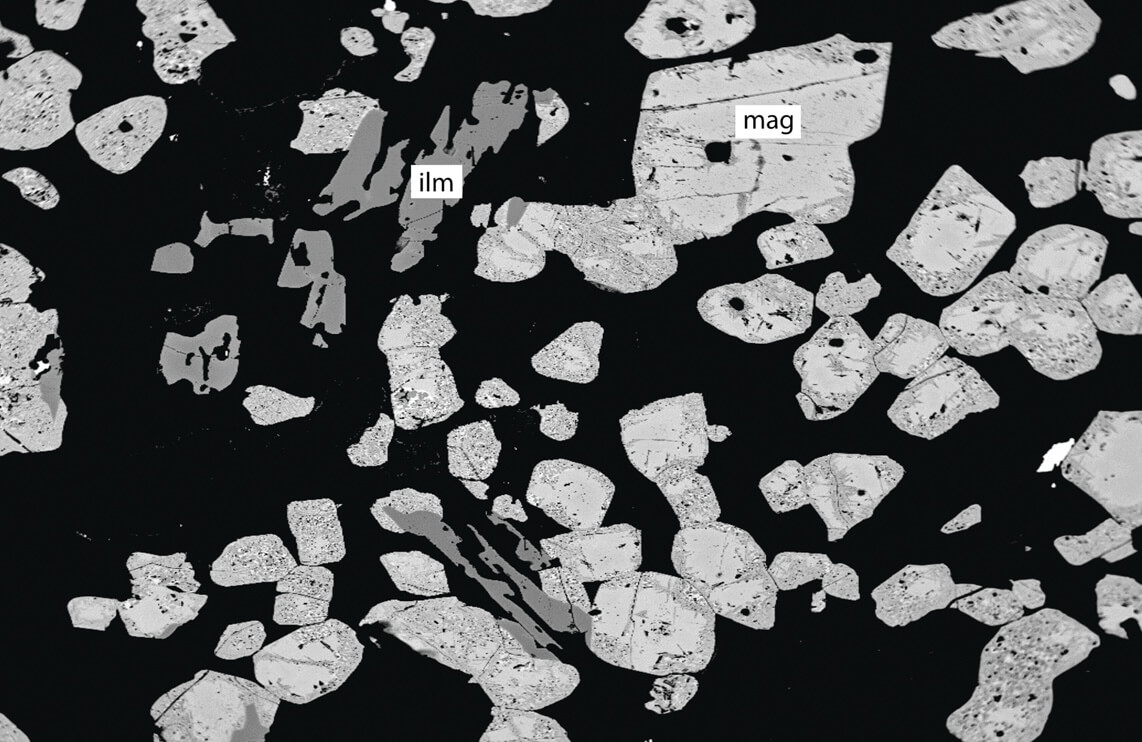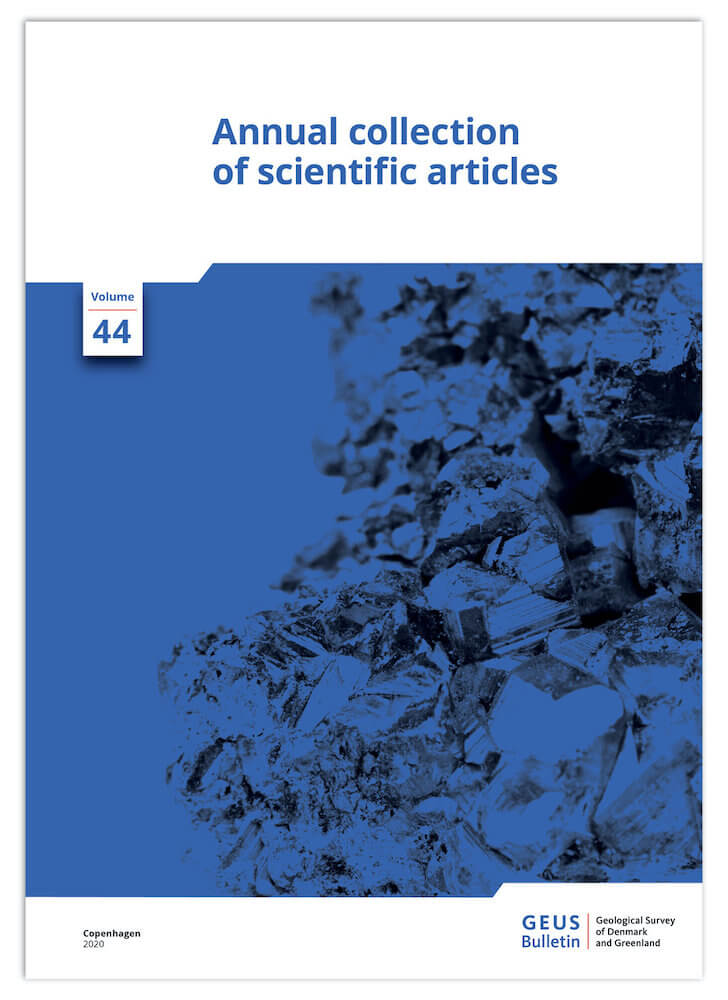
How to Cite
Share
Abstract
The Isortoq Giant Dykes in the Proterozoic Gardar Province, South Greenland, include the Isortoq South giant dyke and the Isortoq North giant dyke. The fine-grained Fe-Ti-V deposit hosted by the Isortoq South giant dyke, referred to as the Isortoq Fe-Ti-V deposit, is considered a good test site for the use of magnetic susceptibility for the mapping of ore grades. Here, we test this and show that the Fe, Ti and V distribution is controlled by titanomagnetite disseminated throughout fine-grained troctolite. The deposit displays a clear correlation between magnetic susceptibility and Fe, Ti and V grades in bulk samples of consecutive 2 m sections from 11 drill cores, totalling 2671 m in length. We observe that Fe, Ti and V are almost entirely hosted in titanomagnetite, which controls the magnetic susceptibility. Field measurements of the magnetic susceptibility can thus be considered as a reliable exploration tool for this type of mineralisation. We further consider the origins of the deposit by reconnaissance petrography, mineral and bulk rock chemistry of the large mass of aphanitic Fe-rich troctolite in the Isortoq South giant dyke. We suggest that the deposit may represent the base of a basanitic to trachybasaltic magma chamber, in which Fe-rich immiscible melts accumulated, crystallised and fractionated. The processes suggested here may apply to other giant dykes and intrusions of the Gardar Province.
How to Cite
Share
Copyright (c) 2020 Diogo Rosa, Alessandro Sandrin, Troels Nielsen, Høgni Vesturklett

This work is licensed under a Creative Commons Attribution 4.0 International License.
Supplementary Files
Downloads
References
-
Bartels, A., Nielsen, T.F.D., Lee, S.R. & Upton, B. 2015: Petrological and geochemical characteristics of Mesoproterozoic dyke swarms in the Gardar Province, South Greenland: evidence for a major sub-continental lithospheric mantle component in the generation of the magmas. Mineralogical Magazine 79(4), 909–939. https://doi.org/10.1180/minmag.2015.079.4.04
-
Bridgwater, D. 1967: Feldspathic inclusions in the Gardar igneous rocks of South Greenland and their relevance to the formation of major anorthosites in the Canadian Shield. Canadian Journal of Earth Sciences 4, 995–1014. https://doi.org/10.1139/e67-068
-
Caira, N. 2012: NI43-101 Technical report on the Iron-Titanium-Vanadium potential of the Isortoq property, South Greenland, a territory of Denmark. Prepared by Argonaut Gold Odysseys Inc. on behalf of West Melville Metals Inc., 88 pp. http://www.aimva.com.au/LiteratureRetrieve.aspx?ID=185310
-
Chadwick, B. & Garde, A.A. 1996: Palaeoproterozoic oblique plate convergence in South Greenland: a re-appraisal of the Ketilidian orogen. In: Brewer, T.S. (ed): Precambrian crustal evolution in the North Atlantic region. Geological Society Special Publication (London) 112, 179–196. https://doi.org/10.1144/GSL.SP.1996.112.01.10
-
Charlier, B. & Grove, T.L. 2012: Experiments on liquid immiscibility along tholeiitic liquid lines of descent. Contributions to Mineralogy and Petrology 164, 27–44. https://doi.org/10.1007/s00410-012-0723-y
-
Ferguson, J. 2010: Report on Exploration Licence 2009/38 Kuutsiaq. Unpublished report, Hunter Minerals Pty Ltd., 36 pp. https://data.geus.dk/gg_detail/?cat=rap&id=86591
-
Ferguson, J. 2013: Isortoq project geological report – 2012. Unpublished report, Hunter Minerals Pty Ltd., 153 pp. https://data.geus.dk/gg_detail/?cat=rap&id=89801
-
Hrouda, F., Chlupacova, M. & Chadima, M. 2009: The use of magnetic susceptibility of rocks in geological exploration (case histories study), a Terraplus report. https://www.geomatrix.co.uk/cms/resources/downloads/the-use-of-magnetic-susceptibility-of-rocks-in-geological-exploration-v1-1.pdf
-
Le Maitre, R.Wet al.. (ed.) 2002: Igneous rocks: a classification and glossary of terms. Recommendations of the International Union of Geological Sciences Subcommission of the Systematics of Igneous Rocks. 236 pp. Cambridge University Press. https://doi.org/10.1017/CBO9780511535581
-
Nielsen, T.F.D., Rudashevsky, N.S., Rudashevsky, V.N., Weatherley, S.M. & Andersen, J.C. Ø. 2020: Elemental distributions and mineral parageneses of the Skaergaard PGE–Au Mineralization: consequences of accumulation, redistribution, and equilibration in an upward-migrating mush zone. Journal of Petrology, 60, 1903–1934. https://doi.org/10.1093/petrology/egz057
-
Pulvertaft, T.C.R. 2008: Field relations, petrography and chronology of the component units of the western part of the Palaeoproterozoic Julianehåb batholith, South Greenland. Danmarks og Grønlands Geologiske Undersøgelse Rapport 2008/70, 55 pp.
-
Sandrin, A., Edfelt, Å., Waight, T.E., Berggren, R. & Elming, S.-Å. 2009: Physical properties and petrologic description of rock samples from an IOCG mineralized area in the northern Fennoscandian Shield, Sweden. Journal Geochemical Exploration 103, 80–96. https://doi.org/10.1016/j.gexplo.2009.07.002
-
Sandrin, A. & Elming, S.-Å. 2006: Geophysical and petrophysical study of an iron oxide copper gold deposit in northern Sweden. Ore Geology Reviews 29, 1–18. https://doi.org/10.1016/j.oregeorev.2005.06.001
-
Sandrin, A. & Elming, S.-Å. 2007: Physical properties of rocks from borehole TJ71305 and geophysical outline of the Tjårrojåkka Cu-prospect, northern Sweden. Ore Geology Reviews 30, 56–73. https://doi.org/10.1016/j.oregeorev.2006.02.002
-
Turner, A.J. & Nicholls, S.J. 2013: NI43-101 Technical Report on an initial resource estimate for the Isortoq Fe-Ti-V project, Qaqortoq district, South Greenland. Prepared by APEX Geoscience Ltd. on behalf of West Melville Metals Inc., 125 pp. https://data.geus.dk/gg_detail/?cat=rap&id=93978
-
Upton, B.G.J. 2013: Tectono-magmatic evolution of the younger Gardar southern rift, South Greenland. Geological Survey of Denmark and Greenland Bulletin 29, 124 pp. https://doi.org/10.34194/geusb.v29.4692









